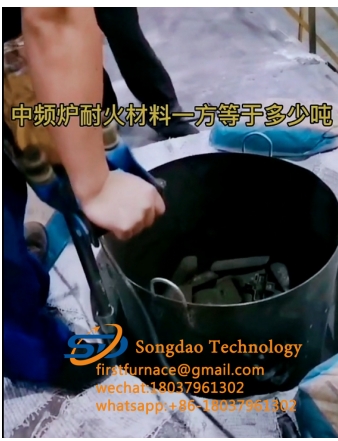- 11
- Apr
The correct use of the inner lining material of the induction furnace and the method of building the furnace
The correct use of the inner lining material of the induction furnace and the method of building the furnace
1. What is introduced here is: Quartz acid dry furnace wall lining ramming material (acid furnace wall lining material). This material is a pre-mixed dry ramming mixture. The content of binder, anti-cracking agent and stabilizer has been prepared according to the needs, and the user can directly put it into use. Special attention: users are not allowed to add any materials and water when using. This product is suitable for smelting gray iron, white iron, carbon steel, high gong steel, high chromium steel, alloy steel, particle steel, washing material, copper, aluminum and other materials in induction furnace.
2. Furnace building, oven and sintering process
Before dry-knotting the furnace wall lining, first lay a layer of asbestos cloth in the furnace coil insulation layer, and manually level and compact each layer of material during laying.
Knotted furnace bottom: The thickness of the furnace bottom is about 200mm-280mm, and the sand is filled in two to three times to prevent uneven density everywhere when manual knotting, and the furnace wall lining after baking and sintering is not dense. Therefore, the thickness of the feed must be strictly controlled. Generally, the thickness of the sand filling is not more than 100mm/each time, and the furnace wall is controlled within 60mm. Multi-person operation is divided into shifts, 4-6 people per shift, 30 minutes substitutions each time knotting, around the furnace Rotate slowly and apply evenly to avoid uneven density.
When the knots at the bottom of the furnace reach the required height, the crucible mold can be placed by scraping it flat. In this regard, care should be taken to ensure that the crucible mold is concentric with the coil, adjusted vertically up and down, and the shape is as close as possible to the bottom of the built furnace. After adjusting the peripheral clearance to be equal, use three wooden wedges to clamp, and the middle hoisting weight is pressed on to avoid the furnace wall from hitting. Displacement of quartz sand occurs during knotting.
Knotting furnace wall: The thickness of the inner lining of the furnace wall is 90mm-120mm, adding dry knotting material in batches, the cloth is uniform, the thickness of the filler is not more than 60mm, and the knotting is 15 minutes (manual knotting) until it is flush with the upper edge of the coil . The crucible mold is not taken out after the knotting is completed, and it plays a role of reaction heating during drying and sintering. If you want to take out the crucible mold, wrap the outer wall of the crucible mold with 2-3 layers of newspaper before knotting the furnace wall and wrap it tightly with tape. After the knotting, the furnace wall is heated up to 900 degrees, and the newspaper is smoked. Take out the crucible mold quickly. The iron barrel with the diameter of 10-15 cm and the height of the furnace mouth is flat and the iron pin is used for the reaction heating during drying and sintering.
Baking and sintering specifications: in order to obtain the three-layer structure of the furnace wall lining, the baking and sintering process is roughly divided into three stages: pay attention to the iron pin and small iron added in the furnace during the baking and sintering Do not add large pieces of iron, pointed or toothed iron.
Baking stage: Heat the crucible mold to 900°C for 20 minutes at a rate of 200 heat preservation for 20 minutes, 300 heat preservation for 20 minutes, and 400 heat preservation for 20 minutes. The purpose is to completely remove the moisture in the furnace wall lining.
Semi-sintering stage: Keep the temperature at 400 for 20 minutes, 500 for 20 minutes, and 600 for 20 minutes. The heating rate must be controlled to prevent cracks.
Complete sintering stage: high temperature sintering, the sintered structure of the crucible is the basis for improving its service life. The sintering temperature is different, the thickness of the sintering layer is insufficient, and the service life is significantly reduced.
In the 2T induction furnace, about 950 kilograms of iron pins are added to enhance the heating effect of the coil during the baking process. As the baking and sintering continue, a relatively stable electromagnetic force is generated through low-power transmission to stir the molten iron to fill the furnace. The furnace temperature is raised to 1700 degrees to keep the temperature for 60 minutes, so that the inner lining of the furnace wall is heated evenly up and down. Strictly control the temperature of the three phase transition zones of quartz sand, promote the full phase transition of quartz sand, and improve the first sintering strength of the furnace wall lining.
3. Summary
For the life of the furnace wall lining of the induction furnace, in addition to ensuring a complete and reasonable three-layer furnace wall lining, attention should also be paid to the usual operation. Scientific baking and sintering norms, strict operation process, can extend the life of the furnace.
4. Packaging and storage methods
Multi-layer moisture-proof paper and inner film packaging 25kg/bag, store in a dry place to prevent moisture absorption. Shelf life recommendations are too good

